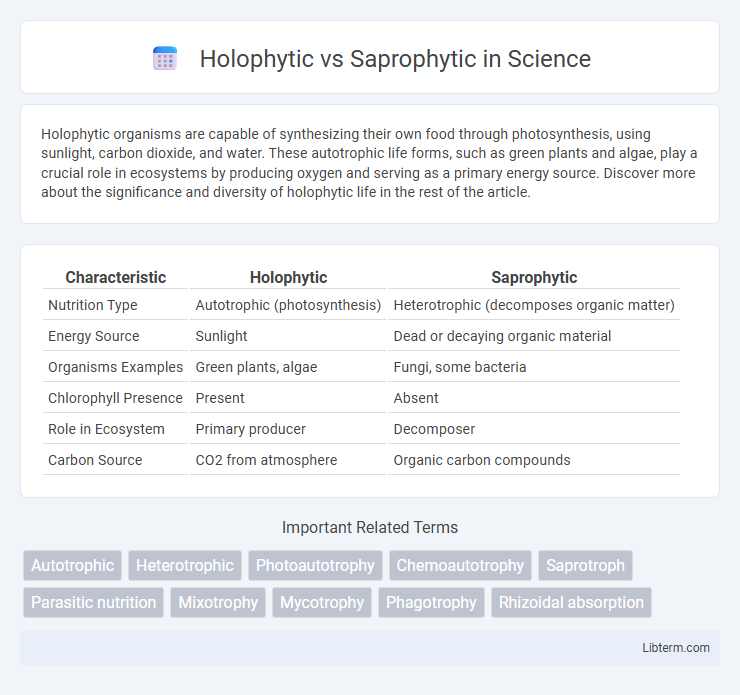Holophytic organisms are capable of synthesizing their own food through photosynthesis, using sunlight, carbon dioxide, and water. These autotrophic life forms, such as green plants and algae, play a crucial role in ecosystems by producing oxygen and serving as a primary energy source. Discover more about the significance and diversity of holophytic life in the rest of the article.
Table of Comparison
| Characteristic | Holophytic | Saprophytic |
|---|---|---|
| Nutrition Type | Autotrophic (photosynthesis) | Heterotrophic (decomposes organic matter) |
| Energy Source | Sunlight | Dead or decaying organic material |
| Organisms Examples | Green plants, algae | Fungi, some bacteria |
| Chlorophyll Presence | Present | Absent |
| Role in Ecosystem | Primary producer | Decomposer |
| Carbon Source | CO2 from atmosphere | Organic carbon compounds |
Introduction to Holophytic and Saprophytic Nutrition
Holophytic nutrition involves organisms synthesizing their own food through photosynthesis, primarily using sunlight, carbon dioxide, and water to produce glucose and oxygen, typical of green plants and certain algae. Saprophytic nutrition relies on obtaining nutrients by decomposing and absorbing organic matter from dead organisms, a process common in fungi and some bacteria. These two nutritional strategies highlight fundamental differences in energy acquisition and ecological roles within ecosystems.
Definition of Holophytic Nutrition
Holophytic nutrition refers to the mode of nutrition in which organisms synthesize their own food using inorganic substances and sunlight through photosynthesis, primarily observed in green plants and certain algae. This autotrophic process involves chlorophyll capturing light energy to convert carbon dioxide and water into glucose and oxygen. Unlike saprophytic nutrition, which depends on decomposing organic matter, holophytic nutrition enables organisms to be primary producers in ecosystems.
Definition of Saprophytic Nutrition
Saprophytic nutrition refers to the process by which organisms, primarily fungi and certain bacteria, obtain nutrients by decomposing dead and decaying organic matter through extracellular digestion. Unlike holophytic organisms, which synthesize their own food via photosynthesis using sunlight, saprophytes rely entirely on absorbing soluble nutrients released during the breakdown of complex organic compounds. This heterotrophic mode of nutrition plays a crucial role in ecosystem nutrient cycling by recycling organic material back into the soil.
Key Differences Between Holophytic and Saprophytic Organisms
Holophytic organisms perform photosynthesis, synthesizing their own food using sunlight, water, and carbon dioxide, primarily including green plants and algae. Saprophytic organisms obtain nutrients by decomposing dead organic matter, relying on external sources of organic material, commonly fungi and certain bacteria. The key difference lies in their nutritional modes: holophytes are autotrophic and produce energy internally, while saprophytes are heterotrophic, extracting energy from decaying substances.
Importance in Ecosystems and Food Chains
Holophytic organisms, such as green plants and algae, perform photosynthesis, producing organic matter that forms the base of most food chains and supports diverse ecosystems by supplying oxygen and energy. Saprophytic organisms, including fungi and bacteria, decompose dead organic material, recycling nutrients back into the soil, which maintains ecosystem fertility and sustains primary producers. The balance between holophytic production and saprophytic decomposition is essential for nutrient cycling and energy flow in terrestrial and aquatic ecosystems.
Examples of Holophytic Organisms
Holophytic organisms, such as green algae (Chlorophyta), land plants (Bryophytes, Pteridophytes, Angiosperms), and cyanobacteria, perform photosynthesis to produce their own food using sunlight, carbon dioxide, and water. These autotrophs contain chlorophyll and contribute significantly to oxygen production and carbon fixation in ecosystems. In contrast, saprophytic organisms like fungi and some bacteria obtain nutrients by decomposing dead organic matter, playing a crucial role in nutrient recycling.
Examples of Saprophytic Organisms
Saprophytic organisms obtain nutrients by decomposing dead organic matter, playing a crucial role in nutrient cycling within ecosystems. Common examples of saprophytic organisms include fungi such as mushrooms, molds like Penicillium, and bacteria like Bacillus subtilis. These organisms secrete enzymes that break down complex organic substances into simpler compounds, facilitating decomposition and nutrient absorption.
Methods of Nutrition and Energy Acquisition
Holophytic organisms obtain energy through photosynthesis, using chlorophyll to convert sunlight into chemical energy by synthesizing organic compounds from carbon dioxide and water. Saprophytic organisms acquire nutrients by decomposing dead organic matter, secreting enzymes to break down complex substances into simpler molecules that can be absorbed. This fundamental difference in nutrition methods delineates autotrophic energy acquisition in holophytes versus heterotrophic absorption in saprophytes.
Ecological Roles and Benefits
Holophytic organisms, primarily autotrophic plants and algae, contribute to ecosystems by producing oxygen and serving as primary producers that convert solar energy into organic matter, forming the base of food webs. Saprophytic fungi and bacteria play a crucial role in decomposing organic matter, recycling nutrients back into the soil, and maintaining ecosystem health by breaking down dead organisms. These complementary ecological roles ensure energy flow and nutrient cycling, supporting biodiversity and ecosystem stability.
Conclusion: Comparing Holophytic and Saprophytic Modes
Holophytic organisms obtain energy through photosynthesis by converting sunlight into chemical energy, primarily using chlorophyll, whereas saprophytic organisms derive nutrients by decomposing organic matter, playing a crucial role in ecosystem recycling. The contrasting nutritional strategies highlight holophytes' reliance on autotrophic processes and saprophytes' dependence on heterotrophic mechanisms for survival. Understanding these modes emphasizes their ecological significance in energy flow and nutrient cycling within various habitats.
Holophytic Infographic

 libterm.com
libterm.com